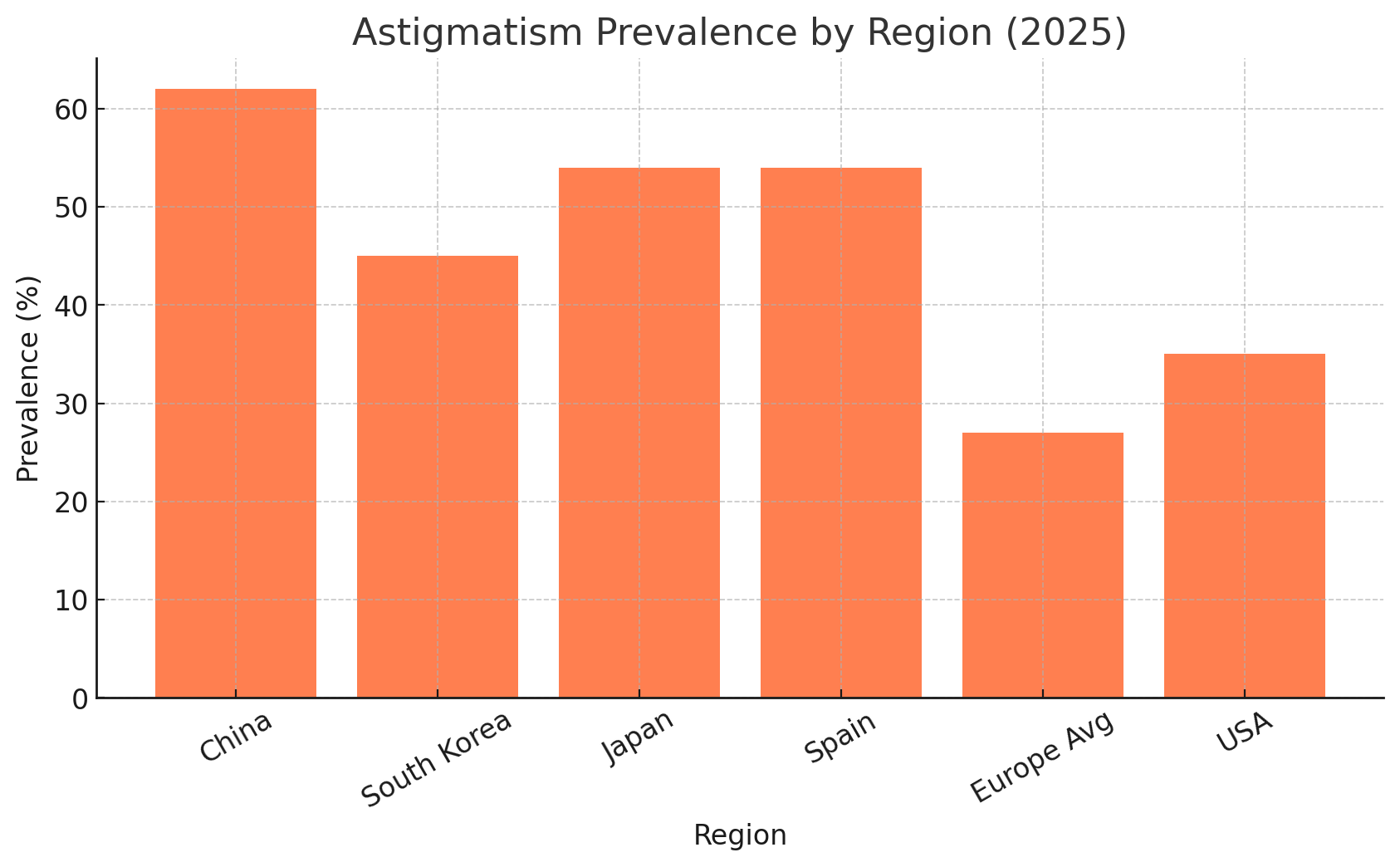From 23.4% before covid to 34.7% in 2022-2023
Astigmatism, a prevalent refractive error which is characterized by an irregular curvature of the cornea or lens, will often lead to blurred or distorted vision in terms of all distances. As of 2025, astigmatism really continues to impact global eye health quite significantly, affecting individuals across various age groups, regions and demographics.
Global Prevalence of Astigmatism
Astigmatism is still one of the most common refractive errors globally. Studies point out that its prevalence in the general population varies so widely, ranging from 8% to 62%. Higher rates are observed in individuals aged 70 and above, which points to an age-related increase in terms of having the condition.
Age-Related Variations
• Children and Adolescents: Recent studies have highlighted an increase in astigmatism among younger populations. For instance, a study conducted in Hong Kong reported that the prevalence of refractive astigmatism in children aged from 6 to 8 years increased from 23.4% before the covid pandemic to 34.7% in 2022-2023. This rise is mainly determined as being caused by lifestyle changes during the pandemic, which included increased screen time and reduced outdoor activities.
• Adults: In adults, astigmatism varies by region and age. In Northern and Western Europe, studies have reported a prevalence of approximately 27%, while in the United States, figures range from 11% to 46%. Prevalence of the condition tends to increase with age, with higher rates observed in individuals over 40 years.

Gender Differences
Variations in astigmatism prevalence have been observed with regards to gender, but findings are inconsistent:
• Some studies report higher prevalence rates in males compared to females.
• Other research indicates a higher prevalence in females.
These variations suggest that differences based on gender in terms of astigmatism may be influenced by various factors, which includes genetics and environmental exposures.
Regional Variations
Astigmatism prevalence varies significantly across different regions:
• Asia: China reports some of the highest rates of astigmatism, with studies indicating figures as high as 62%. In South Korea and Japan, rates range from 31% to 58% and around 54%, respectively.
• Europe: In Northern and Western Europe, the prevalence is approximately 27%, while Spain reports higher rates around 54%.
• North America: The United States exhibits a wide range of prevalence, from 11% to 46%, reflecting diverse demographic and environmental factors that vary from county to county.

Below is an overview of astigmatism rates in South America, Africa and Asia:
South America:
• Guna Indigenous Population in Panama: A study focusing on the Guna people reported a notably high prevalence of astigmatism:
- Children (under 20 years): 41.0%
- Adults (over 30 years): 51.8%
These figures are significantly higher than global averages, suggesting that certain indigenous groups experience elevated rates of astigmatism.
Africa:
• South African High School Children: Research among Black South African high school students found:
- Clinically significant astigmatism: 3.1%
- Various forms of astigmatism: 32.8%
• School-going Adolescents in Ghana: A study reported:
- Astigmatism prevalence: 36%
Asia:
• Children and Adolescents in Xinjiang, China: A comprehensive study involving over 71,000 students aged 7 to 19 years revealed:
- Astigmatism prevalence: 36.1%
• Singaporean Adults (over 40 years): Research indicated:
- Astigmatism prevalence: 58.8%
• Paediatric Population in Hong Kong: A study found:
- Refractive astigmatism prevalence (2022-2023): 34.7%
Economic and Social Implications
Uncorrected astigmatism can lead to significant economic and social burdens:
• Productivity Loss: Individuals with uncorrected astigmatism may experience decreased productivity due to visual discomfort and performance loss.
• Educational Impact: Children with uncorrected astigmatism may face challenges in terms of their academic performance, which could lead to long term educational disadvantages.
• Healthcare Costs: The need for corrective measures, such as glasses, contact lenses or even surgical interventions, contributes to healthcare expenditures for both the individuals affected and their countries’ healthcare systems.
Conclusion
Astigmatism continues to be a prevalent refractive error worldwide in 2025 but there are significant variations observed across ages, genders and regions. The increase in prevalence among children, especially due to the lifestyle changes caused by covid reinforces the need for proactive eye care strategies. Addressing the global burden of astigmatism really requires public health initiatives with a focus on early detection, access to corrective measures and education on eye health.
Sources:
https://journals.lww.com/optvissci/fulltext/2023/0...
https://www.expertmarketresearch.com/epidemiology-...
https://www.ajmc.com/view/prevalence-severity-of-a...
https://www.thebusinessresearchcompany.com/report/...
https://conexiant.com/optometry/articles/study-fin...
https://www.ajmc.com/view/prevalence-severity-of-a...
https://www.optometrytimes.com/view/study-finds-in...
https://www.thebusinessresearchcompany.com/market-...
https://world.einnews.com/pr_news/796513578/global...
https://medicalxpress.com/news/2025-03-prevalence-...
https://www.news-medical.net/news/20250324/Astigma...
https://europe.ophthalmologytimes.com/view/increas...
https://jamanetwork.com/journals/jamaophthalmology...
https://pmc.ncbi.nlm.nih.gov/articles/PMC11910701/
https://www.expertmarketresearch.com/epidemiology-...
https://www.eye-deology.com/fyeyes/5-interesting-s...
https://bmcophthalmol.biomedcentral.com/articles/1...
https://www.ncbi.nlm.nih.gov/books/NBK582142/
https://pmc.ncbi.nlm.nih.gov/articles/PMC10045990/
https://journals.lww.com/optvissci/fulltext/2023/0...
https://www.sciencedirect.com/science/article/pii/...
https://www.gavinpublishers.com/article/view/preva...
https://pmc.ncbi.nlm.nih.gov/articles/PMC5870290/
https://www.tandfonline.com/doi/full/10.1080/23312...
https://bmcophthalmol.biomedcentral.com/articles/1...
https://www.optometrytimes.com/view/study-finds-in...
Author: John Dreyer Optometrist Bsc(Hons), MCOPTOM, DipCLP
Created: 8 Apr 2025, Last modified: 9 Apr 2025

